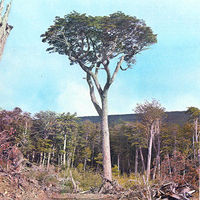Nothofagus betuloides
| Nothofagus betuloides subsp. var. | ||||||||||||||||||||||||||||||||||||||||||||||||||||||||
|---|---|---|---|---|---|---|---|---|---|---|---|---|---|---|---|---|---|---|---|---|---|---|---|---|---|---|---|---|---|---|---|---|---|---|---|---|---|---|---|---|---|---|---|---|---|---|---|---|---|---|---|---|---|---|---|---|

|
|
| ||||||||||||||||||||||||||||||||||||||||||||||||||||||
| ||||||||||||||||||||||||||||||||||||||||||||||||||||||||
Nothofagus betuloides (Magellan's beech) is an evergreen tree, up to 25 meters (82 feet), columnar appearance, in its natural environment it tolerates cold winters and absence of heat in summer. Found from sea level to 500 meters (1600 ft). It is sometimes known by the common name guindo.
It grows from southern (40° lat S) to Tierra del Fuego (56° lat S), specimens from the southern forests resist temperatures down to −20°C (−4°F).
It succeeds in Scotland. Trees planted in Faroe Islands, which were imported directly from its southernmost distribution in Tierra del Fuego, have turned out to be very hardy.[1]
The wood has beautiful marks, is pinkish, hard, semi-heavy and is used in furniture and building.
Cultivation
Propagation
Pests and diseases
Varieties
Gallery
-
photo 1
-
photo 2
-
photo 3
References
- ↑ Højgaard, A., J. Jóhansen, and S. Ødum (eds) 1989. A century of tree planting in the Faroe Islands. Føroya Frodskaparfelag, Torshavn.
- Standard Cyclopedia of Horticulture, by L. H. Bailey, MacMillan Co., 1963
External links
- w:Nothofagus betuloides. Some of the material on this page may be from Wikipedia, under the Creative Commons license.
- Nothofagus betuloides QR Code (Size 50, 100, 200, 500)
